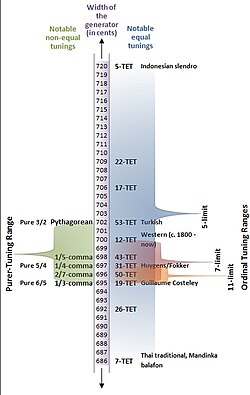Regular temperament
 From Wikipedia the free encyclopedia
From Wikipedia the free encyclopedia

A regular temperament is any tempered system of musical tuning such that each frequency ratio is obtainable as a product of powers of a finite number of generators, or generating frequency ratios. For instance, in 12-TET, the system of music most commonly used in the Western world, the generator is a tempered fifth (700 cents), which is the basis behind the circle of fifths.
When only two generators are needed, with one of them the octave, this is sometimes called a "linear temperament". The best-known example of linear temperaments are meantone temperaments, where the generating intervals are usually given in terms of a slightly flattened fifth and the octave. Other linear temperaments include the schismatic temperament of Hermann von Helmholtz and miracle temperament.
Mathematical description
[edit]If the generators are all the prime numbers up to a given prime p, we have what is called p-limit just intonation. Sometimes some irrational number close to one of these primes is substituted (an example of tempering) to favour other primes, as in twelve tone equal temperament where 3 is tempered to 219⁄12 to favour 2, or in quarter-comma meantone where 3 is tempered to 24√5 to favor 2 and 5.
In mathematical terminology, the products of these generators define a free abelian group. The number of independent generators is the rank of an abelian group. The rank-one tuning systems are equal temperaments, all of which can be spanned with only a single generator, though they don't have to be integer-based equal temperaments. The non-octave scales of Wendy Carlos, such as the Alpha scale, use one generator that does not stack up to the octave. A rank-two temperament has two generators; hence, meantone is a rank-2 temperament. For the case of quarter-comma meantone, these may be chosen as and .
In studying regular temperaments, it can be useful to regard the temperament as having a map from p-limit just intonation (for some prime p) to the set of tempered intervals. To properly classify a temperament's dimensionality one must determine how many of the given generators are independent, because its description may contain redundancies. Another way of considering this problem is that the rank of a temperament should be the rank of its image under this map.
For instance, a harpsichord tuner it might think of quarter-comma meantone tuning as having three generators—the octave, the just major third (5:4) and the quarter-comma tempered fifth—but because four consecutive tempered fifths produces a just major third, the major third is redundant, reducing it to a rank-two temperament.
Other methods of linear and multilinear algebra can be applied to the map. For instance, a map's kernel (otherwise known as "nullspace") consists of p-limit intervals called commas, which are a property useful in describing temperaments.
External links
[edit]- "Regular Temperament", on Xenharmonic Wiki.
- A. Milne, W. A. Sethares, and J. Plamondon, Isomorphic Controllers and Dynamic Tuning— Invariant Fingering Over a Tuning Continuum, Computer Music Journal, Winter 2007
- Holmes, Rich, Microtonal scales: Rank-2 2-step (MOS) scales
- Smith, Gene Ward, Regular Temperaments
- Barbieri, Patrizio. Enharmonic instruments and music, 1470-1900. (2008) Latina, Il Levante Libreria Editrice

